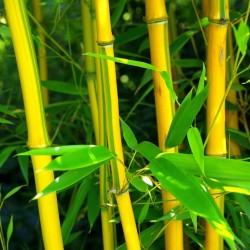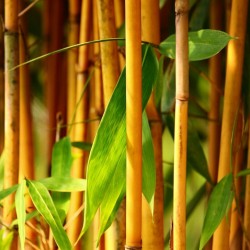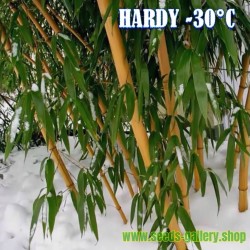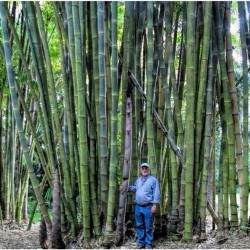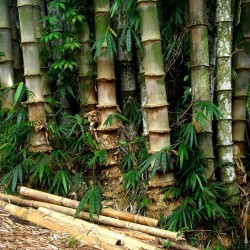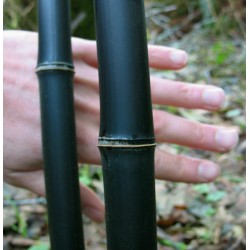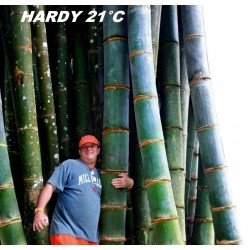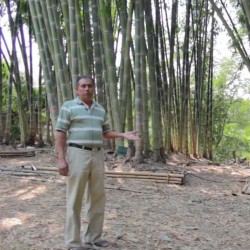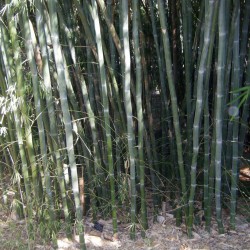Seeds Gallery Com,
5/
5
<h2><span style="font-size:14pt;"><strong>Male bamboo Seeds - Calcutta bamboo - Solid bamboo (Dendrocalamus strictus)</strong></span></h2>
<h2><span style="color:#ff0000;"><strong><span style="font-size:14pt;">Price for Package of 5 or 20 seeds.</span></strong></span></h2>
<div>Dendrocalamus strictus, also know as iron or male bamboo, calcutta bamboo or solid bamboo is a giant bamboo, which reaches a maximum height of 60 feet. Maximum diameter of the culms is around 5 inches. The lower parts of the culms are sometimes solid. Dendrocalamus strictus has small, light green, furry leaves. Its strong, lower erect, grey-green, slightly rough culms form a very tight packed clump. Dendrocalamus strictus is very drought tolerant once established. This is the only bamboo timber that once cured, can be nailed without cracking. Giant clumper, non-invasive. Supreme material in building furniture.</div>
<div>
<div>Plant in full sun or light shade.</div>
<div>Moso is somewhat more difficult to establish than are other bamboos.</div>
<div>Some claim that it is helpful to start with a large division.</div>
<div>Rhizome divisions are generally unsuccessful.</div>
<div>Moso has a strong preference for well-drained, red clay soils. As Landscape Ornamental Plant</div>
<div>Soak your seeds in about 85° F (30° C) water for 24 hours. Make sure it doesn’t get too hot, as temperatures over 105° F (40° C) can kill your seeds. Cooler temperatures however, will not hurt the seeds, but may delay germination by a few days.</div>
<div>5</div>
<div>Use a skewer or chopstick to open and rough up the top part of the peat pellets.</div>
<div>6</div>
<div>Put only one seed in the middle of each pellet. Because bamboo seeds are rare and expensive, you don't want to risk having two sprout in the same pellet and have to lose one of them.</div>
<div>7</div>
<div>Add a small amount of “seedling mix�? type potting soil over the top of your seeds. 1/8 to ¼ inch (2 to 5 mm) is enough.</div>
<div>8</div>
<div>Put the mini greenhouse in a location where it will get medium shade. An east-facing window is good if the weather outside is cold, or a moderately shady area outside if the weather is good. NOTE: Wherever you put it, it should not get too much direct sun. Even a mini greenhouse can quickly get up to seed killing temperatures in hot direct sun.</div>
<div>9</div>
<div>Check on the greenhouse daily, as the peat pellets can dry out quickly once the water from main soak evaporates. Before the seeds sprout, they can survive getting too dry once or so. But as soon as they sprout, they can die in a matter of hours if they dry out. If the peat pellets start getting too dry, use a spray bottle to dampen them again. You may need as much as a whole squirt per pellet to dampen to the interior of the pellet.</div>
<div>10</div>
<div>You may see a sprout within 10 days from planting, though the bulk of germination will occur after at least 15 or 20 days. Different species have different germination rates, so don’t get disappointed too soon.</div>
<div>11</div>
<div>If any of the sprouts get tall enough to touch the plastic dome lid while others are still getting started, prop the lid up as necessary to prevent the leaves from touching it… Any leaves resting against the lid will quickly rot and risk killing the seedling.</div>
<div>12</div>
<div>After about 30 days, most of the seeds that are going to sprout with this method will have done so. Transplant all of the healthy sprouts into 4�? (or half-liter) pots using the next few steps. But don’t discard the rest of the seeds yet, as we will jar a few more into action by changing the conditions for them.</div>
<div>13</div>
<div>Mix a good potting soil with about 50% small bark-chip mulch. This makes a potting mix with very high drainage that is good for bamboo.</div>
<div>14</div>
<div>Put a little (1/2 inch or 1 cm minimum) of this potting mix into the pots.</div>
<div>15</div>
<div>Move each pellet that has a sprout into a pot and fill around it so that the pellet is buried at least ¼ inch below the potting soil.</div>
<div>16</div>
<div>Give the pots a good dose of water. Because of the really good drainage, don’t worry too much about over watering.</div>
<div>17</div>
<div>Set these pots in an outdoor location that gets about 50% shade and that never gets full hot direct sun for more than a few minutes at a time. These seedlings are now well on their way. You will likely lose another 10% of them for no apparent reason at all, but the rest will have a good chance at making it to maturity.</div>
<div>18</div>
<div>Go back to the tray of remaining un-sprouted seeds and put the plastic lid aside. Store it for future use if you want, but these seeds and seedlings have no more use for it.</div>
<div>19</div>
<div>If your mini-greenhouse tray has a removable plastic liner that helps organize the pellets, take it out and make several drainage holes in the bottom of the unlined tray.</div>
<div>20</div>
<div>Put all of the pellets back in without the liner. Space them roughly evenly, and keep them the same side up as before… Seeds to the top.</div>
<div>21</div>
<div>Fill in around the pellets with seedling mix type potting soil, and mound it up to cover the top of the pellets by about ¼ inch (5mm).</div>
<div>22</div>
<div>Place this tray outside in the medium to full sun, checking it daily to keep it damp but not too wet. Because of removing the dome and the increased sun, expect to need to water nearly every day. It is probably helpful to switch to a regular watering can at this point, as you can give it a more normal dose of water.</div>
<div>23</div>
<div>Hopefully, you will see a whole new set of seedlings start to come up over the next few weeks. As these start to look ready, take them back to step 12 and get them transplanted.</div>
<div>Giant Bamboo Sowing instr.</div>
</div>
B 3 (5 S)





